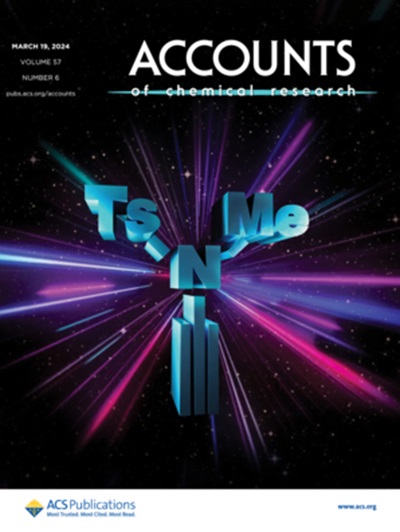Fundamental Insights for Practical Electrocatalytic CO2 Reduction.
IF 17.7
1区 化学
Q1 CHEMISTRY, MULTIDISCIPLINARY
引用次数: 0
Abstract
ConspectusGlobal energy's continuous reliance on fossil fuels has driven unprecedented CO2 emission growth, intensifying climate volatility through heightened frequency and severity of extreme weather events. These crises underscore the critical need for accelerating innovation in sustainable energy technologies capable of reconciling two urgent imperatives: ensuring reliable energy access while delivering measurable progress toward global decarbonization commitments. Electrocatalytic CO2 reduction reaction (CO2RR) technology implementation could not only help to reduce CO2 concentrations in the atmosphere but also provide new possibilities for renewable energy storage, thus playing a crucial role in driving the energy transition and achieving carbon neutrality. To advance the industrialization of this technology, multiple global companies (Sunfire, Germany; Dioxide Materials, USA; Carbon Energy Technology, China, etc.) have initiated pilot-scale research. However, progress has been slow due to challenges related to catalyst, electrode, and electrolyzer design. Through integrated optimizations spanning catalyst structural engineering, electrode configuration fabrication, and electrolyzer system design, we have demonstrated progressive milestones in the technology of CO2RR.This Account systematically presents our research group's groundbreaking contributions to practical CO2RR, spanning catalyst design, electrode architecture fabrication, and advanced electrolyzer development. Based on the current research foundation in our group, we contend that for the industrial-scale development of CO2 reduction reactions, greater emphasis should be placed on catalyst stability rather than solely on catalytic activity. To improve the stability of catalytic systems, several strategies can be implemented, including enhancing electron transfer rate and strengthening interatomic bonds to mitigate catalyst degradation during operation. We have also proposed a strategy for customizing highly efficient catalysts by simulating the degradation path of the catalyst. In addition, we also advocate heightened attention to electrode fabrication processes, encompassing structural design and paired electrolysis configurations, as these factors critically influence the overall system's conversion efficiency, stability and ultimately the economic viability of industrial applications. Additionally, we highlight our progress in electrolyzer research, particularly demonstrating the advantages and potential of the proton exchange membrane (PEM) electrolyzer in CO2 reduction systems. Given their ability to concurrently address challenges such as high CO2 loss rates and the carbonate deposition problem, we propose that this direction needs superior development to advance CO2RR industrialization. Finally, we summarize this Account and propose future research directions, focusing on scalable production of catalysts, CO2 capture technologies, direct flue gas electrolysis, system integration, and economic and environmental assessments. This systematic progress bridges gaps between fundamental electrocatalysis and practical implementation, charting a viable pathway toward carbon-negative chemical manufacturing.实用电催化二氧化碳还原的基本见解。
全球能源对化石燃料的持续依赖推动了前所未有的二氧化碳排放增长,极端天气事件的频率和严重程度都有所提高,加剧了气候的波动性。这些危机凸显了加速可持续能源技术创新的迫切需要,这些技术能够协调两项紧迫任务:确保可靠的能源获取,同时在实现全球脱碳承诺方面取得可衡量的进展。电催化CO2还原反应(CO2RR)技术的实施不仅有助于降低大气中CO2浓度,而且为可再生能源的储存提供了新的可能性,从而在推动能源转型和实现碳中和方面发挥了至关重要的作用。为了推进这项技术的产业化,全球多家公司(德国Sunfire;美国二氧化氧材料公司;碳能源技术,中国等)已经启动了中试规模的研究。然而,由于催化剂、电极和电解槽设计方面的挑战,进展缓慢。通过催化剂结构工程、电极配置制造和电解槽系统设计的集成优化,我们展示了CO2RR技术的进步里程碑。本报告系统地介绍了我们的研究小组对实际CO2RR的开创性贡献,包括催化剂设计,电极结构制造和先进的电解槽开发。基于本课组目前的研究基础,我们认为对于工业化规模的CO2还原反应的发展,应该更加重视催化剂的稳定性,而不仅仅是催化活性。为了提高催化系统的稳定性,可以采用几种策略,包括提高电子转移速率和加强原子间键来减轻催化剂在运行过程中的降解。我们还提出了一种通过模拟催化剂的降解路径来定制高效催化剂的策略。此外,我们还提倡高度关注电极制造工艺,包括结构设计和配对电解配置,因为这些因素对整个系统的转换效率、稳定性和最终工业应用的经济可行性产生重大影响。此外,我们强调了我们在电解槽研究方面的进展,特别是展示了质子交换膜(PEM)电解槽在二氧化碳还原系统中的优势和潜力。鉴于其同时解决高CO2损失率和碳酸盐沉积问题等挑战的能力,我们建议该方向需要进一步发展以推进CO2RR产业化。最后,我们总结了本报告并提出了未来的研究方向,重点是催化剂的规模化生产、二氧化碳捕集技术、直接烟气电解、系统集成以及经济和环境评估。这一系统的进展弥合了基础电催化和实际应用之间的差距,为实现负碳化学制造指明了一条可行的途径。
本文章由计算机程序翻译,如有差异,请以英文原文为准。
求助全文
约1分钟内获得全文
求助全文
来源期刊

Accounts of Chemical Research
化学-化学综合
CiteScore
31.40
自引率
1.10%
发文量
312
审稿时长
2 months
期刊介绍:
Accounts of Chemical Research presents short, concise and critical articles offering easy-to-read overviews of basic research and applications in all areas of chemistry and biochemistry. These short reviews focus on research from the author’s own laboratory and are designed to teach the reader about a research project. In addition, Accounts of Chemical Research publishes commentaries that give an informed opinion on a current research problem. Special Issues online are devoted to a single topic of unusual activity and significance.
Accounts of Chemical Research replaces the traditional article abstract with an article "Conspectus." These entries synopsize the research affording the reader a closer look at the content and significance of an article. Through this provision of a more detailed description of the article contents, the Conspectus enhances the article's discoverability by search engines and the exposure for the research.
 求助内容:
求助内容: 应助结果提醒方式:
应助结果提醒方式:


